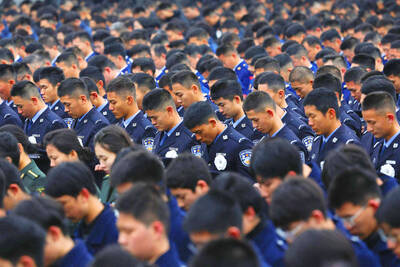A cave discovered near the source of Indonesia’s massive earthquake-spawned tsunami contains the footprints of past gigantic waves dating up to 7,500 years ago, a rare natural record that suggests the next disaster could be centuries away — or perhaps only decades.
The findings provide the longest and most detailed timeline for tsunamis that have occurred off the far western tip of Sumatra Island in Aceh Province. That is where 30m waves triggered by a magnitude 9.1 earthquake on Dec. 26, 2004, killed 230,000 people in several countries, more than half of them in Indonesia.
The limestone cave, located within a couple hundred meters of the coast near Banda Aceh, is about 1m above high tide and protected from storms and wind. Only huge waves that inundate the coastal area are able to gush inside.
Researchers in 2011 uncovered seabed sand deposits that were swept into the cave over thousands of years and neatly layered between bat droppings like a geological cake. Radiocarbon analysis of materials, including clamshells and the remains of microscopic organisms, provided evidence of 11 tsunamis before 2004.
The disasters were by no means evenly spaced, said lead researcher Charles Rubin from the Earth Observatory of Singapore.
The last one occurred about 2,800 years ago, but there were four others in the preceding 500 years, he said.
And it is possible there were others. Researchers know, for instance, that there were two mammoth earthquakes in the region in about 1393 and 1450.
Rubin said a big tsunami could have carried away evidence of other events through erosion.
The scientists are still working to determine the size of the waves that entered the cave.
“The take-home message is perhaps that the 2004 event doesn’t mean it won’t happen for another 500 years,” said Rubin, who added that the cave was discovered by chance and not part of planned field work.
“We did see them clustered together closer in time. I wouldn’t put out a warning that we’re going to have an earthquake, but it shows that the timing is really variable,” Rubin added.
The quake that triggered the 2004 tsunami surprised scientists because the fault that unleashed the megathrust temblor had been quiet for hundreds of years.
Since the last big earthquake had struck more than 500 years earlier, there was no surviving oral history that could have helped people understand the risk.
Since 2004, much research has been done to try to learn about the area’s past by examining sand deposits, uplifted coral and GPS data.
“The findings are very significant,” Katrin Monecke, a geosciences professor at Wellesley College in Massachusetts wrote in an e-mail.
She worked on tsunami sand deposits discovered in marshes in the area, but was not involved with the cave research, which was presented this month at an American Geophysical Union conference in San Francisco, California.
“The sand sheets in the cave cover a very long time span and give an excellent idea about earthquake frequency,” she added.
Despite the long record preserved in the cave, Rubin said it did not provide any clear clues about tsunami frequency or when events might happen in a relatively close period of time.
Geologist Kerry Sieh, director of the Singapore group and also part of the cave investigation, has predicted that another monster quake could rock the area in the next few decades. They tend to come in cycles and the 2004 temblor heaped more pressure on the fault. However, the history is so variable, it is impossible to make an exact forecast.
“By learning about the type of tsunamis that happened in the past, maybe we can do planning for mitigation for the next tsunami,” said Nazli Ismail, head of the physics and geophysics department at Syiah Kuala University in Banda Aceh, who worked on the project.

The Burmese junta has said that detained former leader Aung San Suu Kyi is “in good health,” a day after her son said he has received little information about the 80-year-old’s condition and fears she could die without him knowing. In an interview in Tokyo earlier this week, Kim Aris said he had not heard from his mother in years and believes she is being held incommunicado in the capital, Naypyidaw. Aung San Suu Kyi, a Nobel Peace Prize laureate, was detained after a 2021 military coup that ousted her elected civilian government and sparked a civil war. She is serving a

China yesterday held a low-key memorial ceremony for the 1937 Nanjing Massacre, with Chinese President Xi Jinping (習近平) not attending, despite a diplomatic crisis between Beijing and Tokyo over Taiwan. Beijing has raged at Tokyo since Japanese Prime Minister Sanae Takaichi last month said that a hypothetical Chinese attack on Taiwan could trigger a military response from Japan. China and Japan have long sparred over their painful history. China consistently reminds its people of the 1937 Nanjing Massacre, in which it says Japanese troops killed 300,000 people in what was then its capital. A post-World War II Allied tribunal put the death toll

‘NO AMNESTY’: Tens of thousands of people joined the rally against a bill that would slash the former president’s prison term; President Lula has said he would veto the bill Tens of thousands of Brazilians on Sunday demonstrated against a bill that advanced in Congress this week that would reduce the time former president Jair Bolsonaro spends behind bars following his sentence of more than 27 years for attempting a coup. Protests took place in the capital, Brasilia, and in other major cities across the nation, including Sao Paulo, Florianopolis, Salvador and Recife. On Copacabana’s boardwalk in Rio de Janeiro, crowds composed of left-wing voters chanted “No amnesty” and “Out with Hugo Motta,” a reference to the speaker of the lower house, which approved the bill on Wednesday last week. It is

FALLEN: The nine soldiers who were killed while carrying out combat and engineering tasks in Russia were given the title of Hero of the Democratic People’s Republic of Korea North Korean leader Kim Jong-un attended a welcoming ceremony for an army engineering unit that had returned home after carrying out duties in Russia, North Korean state media KCNA reported on Saturday. In a speech carried by KCNA, Kim praised officers and soldiers of the 528th Regiment of Engineers of the Korean People’s Army (KPA) for “heroic” conduct and “mass heroism” in fulfilling orders issued by the ruling Workers’ Party of Korea during a 120-day overseas deployment. Video footage released by North Korea showed uniformed soldiers disembarking from an aircraft, Kim hugging a soldier seated in a wheelchair, and soldiers and officials